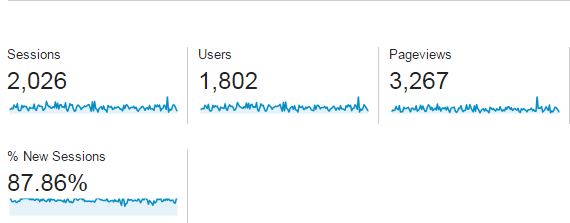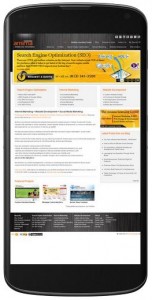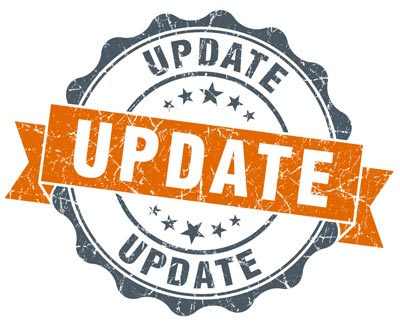
After two and a half years with the help of Sir Linksalot, we finally upgraded our website.
There are many reasons as to why we did not do it for soo long. Some valid. Some not.We learned some very harsh lessons and we wanted to share them.
During this time, we learned some very harsh lessons and we want to share them with you.
So, here goes…
What do you think happened when we did not update our website? Our rank dropped on all search engines. That was expected.
We lost a ton of traffic. That too was expected. Our inbound leads dried up. That, also, was no surprise.
We did not sign up a lot of new customers. Our competitors leapfrogged right past us. Our call volume decreased. Our bottom line was affected. Again, all expected.
And then, there also a few things that we did not anticipate.
Here’s a detailed look at that happened:
Outcomes that were Expected
1. Search Rank Drop
Back in early 2013, we ranked in the top 10 on Google, Bing and Yahoo (see below) for over 200 search terms. We were actually at #1 for some 50 search terms, ones that are most relevant to our business. This generated a ton of traffic and inbound leads.
Fast forward to 2015. We currently rank in 40+ position for the same search terms and that is pretty much useless for all intents and purposes.
Google, especially, has become adept at identifying web properties that do not remain relevant because of a lack of fresh content and blog updates. It is a well-known fact that content updates are critical so you can maintain proper search engine rank.
Here is our Rank in 2012/2013. You can see that we were in the top 10 search results on all Bing/Yahoo and Google:
As of the writing of this article, at best, we are in the 50 – 100+ for the above keywords.
Lesson Learned: Search engine algorithms are very sophisticated and can very quickly flag websites that have “stale” content. So make sure you update the content in your site regularly.
2. Web Traffic Decline
Traffic went down. Seriously. For the most part, traffic depends on search engine rank (among other factors) and if your rank drops, your traffic will more than likely drop correspondingly. It was actually quite painful to watch search engine rank decline ever-so-slowly and to also see traffic decrease accordingly.
Here is a look at traffic stats for January 2013:

Now compare that to traffic stats for the six 6 months of 2015. You will see a 90% decline across the board!

We went from about 300 unique visitors per day down to less than 10 unique visitors per day. That was a loss of more than 90%.
Lesson Learned: Visitor traffic is heavily dependent on your search engine rank. If people cannot find you, your website will not get traffic. If visitors don’t like what they see or cannot find what they are looking for, they will leave.
3. Decline in Inbound Leads.
Our inbound leads declined. We went from 15-18 inbound requests per day down to 2-3 requests per week.
As an Internet marketing and website development company, we are dependent upon good quality inbound leads. Of course, we also do outbound marketing activities as part of our marketing efforts those are limited and inbound marketing still takes the cake. The decline in search engine rank corresponds to a reduction in traffic and that translates into significantly fewer inbound leads.
Lesson Learned: As a business that is highly dependent on inbound leads, it is critically important to monitor, manage and search rank along with social presence in addition to continuous content updates.

4. Mobile Visitors
This is how our website appeared on a smartphone.
Because our website was not responsive and because we didn’t have a dedicated mobile website, we were losing close to 90 to 95% of all mobile visitors. The new website is 100% responsive and automatically scales to fit the screen of the device accessing it.
We have kept the design and layout simple and easy to work with. We have successfully avoided the temptation of excessive visual elements, however, we are conducting split A/B tests and that may change in the near future.
Lesson Learned: Your website should be 100% mobile-friendly. Google has a nifty tool that lets you check the mobile friendliness and will give you a breakdown of any issues that it discovers. A responsive website is the best way to go.
5. Loss of Credibility
This is an interesting one.
Credibility is dependent upon search engine rank, traffic stats, inbound leads, portfolio and such other important signals. Essentially, everything is tied at the hip. So if you lose rank, you lose traffic, you automatically lose credibility because you are no longer found in the top listings on search engines. I had included a paragraph of tigrinya translations in the website, hoping to appeal to the middle eastern audience, but it turned out that even a small paragraph not in english makes a lot of difference.
Lesson Learned: Sure, search engine rank is important but what is almost as important is your credibility. You can learn more about the importance of credibility in Rajeev Ratra’s Paid Advertising vs SEO article.
6. Loss of Existing Customers
We slowly started to lose credibility with existing clients. Because our website was dated and not maintained properly, we actually lost few existing clients to competition. This was probably the most difficult issue to handle.
Lesson Learned: They say that it is more effort and cost intensive to acquire new customers and it is so much better to keep existing customers happy. A lot of what we do is subjective and if we feel that the company we are working with has lost its edge, we will look elsewhere. Work hard to keep your current customers happy.
Not-so-obvious outcomes
7. Former Customers
We periodically reach out and contact former customers to follow up and see if they need any assistance with their online presence.
They would want to see our website to refresh their memory, or perhaps to see where we were placed on search engines. After all, that was how they had found us in the first place! Due to the rank drop and due to a dated website that was not updated, we had a hard time engaging with some former customers.
We also did actually lose a few deals because of an outdated website.
Lesson Learned: We work hard to maintain contact with former customers. Typically, we call them, or email them once every so often. Since there is a level of trust with former customers that left “happy”, it is best
8. Social Profiles
Our social likes and shares literally came to a standstill. Social media is all about sharing in a timely manner. Current events drive social interaction and most people are not interested in yesterday’s news. We have not updated our social profiles nor have we shared updates for just about as long as we have not updated our website.
Lesson Learned: Social media is unforgiving when it comes to certain things, especially dated or old/stale information.
9. It Became Embarrassing
Over time, it became embarrassing to have a dated website. We would hesitate to give our business cards or draw attention to our website because it was so dated. I clearly remember a call earlier year from a prospective client who actually reprimanded us. Quoting him verbatim: “You guys really need a new website! How can I work with a website design and internet marketing company when that cannot even manage and maintain their own website? Why should I trust you to take care of my online presence?”
Lesson Learned: Search engine algorithms have become very sophisticated and can very quickly flag websites that have “stale” content. So make sure you update the content in your site regularly.
10. Prospective Employees
We stopped getting emails from prospective employees, freelancers and people looking to partner with us. On average, we used to get 12-15 such emails or phone calls each week and that has gone down to 0 as of now.
Lesson Learned: Search engine algorithms have become very sophisticated and can very quickly flag websites that have “stale” content. So make sure you update the content in your site regularly.
11. Solicitation E-mails and Telemarketing calls
There was one positive! We used to get a ton of unwanted solicitation calls every day. These dried up pretty quickly as people were not able to find us and had no need to contact us.
Lesson Learned: Search engine algorithms have become very sophisticated and can very quickly flag websites that have “stale” content. So make sure you update the content in your site regularly.
The Bottom Line

In conclusion, we cannot stress enough that you need to stay on top of your web presence. And, if you rely on the Internet for any business or if inbound marketing figures in your overall marketing strategy, make sure that:
- You update your website regularly with relevant and meaningful content that your visitors find interesting
- Your website has a design that is consistent with current trends; older designs look dated and lead to people clicking the close or back button
- Your site is responsive for mobile-device friendliness so it can adapt to the screen size of any device being used to access it
- Your website has relevant social media presence by selecting the right social channels that make sense for your business
- You collect search engine traffic stats, bounce rates, heat maps (if you use them) and other data to proactively identify and correct issues
If you blog, follow a regular schedule and update your blog consistently. Otherwise, don’t blog.
We have since completely overhauled and updated our website, and we are blogging on a regular and consistent frequency.
The best advice I can give you is to update your website regularly and consistently. If you are running WordPress, stay on top of code, plugin, theme and other updates as well.
Have you ever gone a long time without updating your website? If yes, what has been your experience?


